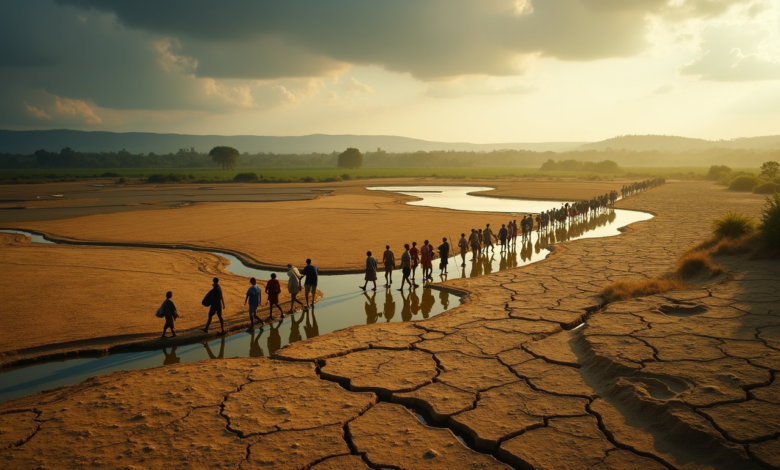
How Environmental Changes Reshape Global Migration Patterns
Nature forces millions of people to abandon their homes every year. They leave because of rising seas, devastating droughts, and extreme weather. These events create a new group of displaced people that changes global migration patterns.
Climate migration has become one of today’s most urgent challenges. People from Pacific islands to Sub-Saharan Africa face this reality daily. Environmental migration experts predict a staggering number – by 2050, climate changes could force 200 million people to become refugees. These people will have to leave their ancestral lands behind. Their movement will alter the map of human settlement and affect cultural traditions, economic systems, and social structures worldwide.
We need to understand how climate drives these population shifts. This piece looks at affected communities’ personal stories and studies their migration patterns. It also shows how vulnerable populations adapt to cope with environmental changes.
The Human Face of Climate Migration
Climate migration statistics tell only part of the story. Behind these numbers are real people with stories of loss, resilience, and adaptation. Monoara Khatun, a 23-year-old from Bangladesh, watched as recurring floods destroyed her village’s rice paddies and homes. She had no choice but to move to Dhaka to find work. Her story shows what climate migrants go through as they rebuild their lives in unfamiliar cities.
Environmental displacement affects people way beyond their physical move. Climate change threatens all but one of three natural heritage sites and one in six cultural heritage sites worldwide. This loss cuts deeper for indigenous and local communities. It disrupts their traditional practices, knowledge systems, and cultural identities passed down through generations.
People who move because of climate change face tough psychological challenges. Research shows displaced communities suffer from higher rates of common mental disorders than local populations. These include depression, anxiety, and post-traumatic stress disorder. Mental health issues hit hardest:
- Children and youth who are twice as likely to develop anxiety and depression compared to their non-displaced peers
- Women who must handle extra responsibilities while managing their family’s displacement
- Elderly people who find it hard to cope with losing their familiar surroundings and community ties
Multiple stressors make the psychological burden worse for climate migrants. Unemployment, poor living conditions, and isolation contribute significantly to mental health problems in displaced groups. Many people start experiencing trauma before they move, and their recovery becomes harder due to complex bureaucracy and limited mental healthcare access.
East Africa clearly shows these challenges. Prolonged droughts have forced communities to leave their ancestral lands. The World Health Organization reports that climate migrants either can’t get mental health services or face major obstacles when trying to access available help.
Understanding Climate-Driven Migration Patterns
Climate change drives unprecedented changes in global demographics through migration. The World Bank estimates that by 2050, 216 million people from six world regions might need to relocate within their countries. Major migration hotspots show concerning numbers:
- Sub-Saharan Africa: 86 million
- East Asia and Pacific: 49 million
- South Asia: 40 million
- North Africa: 19 million
- Latin America: 17 million
- Eastern Europe and Central Asia: 5 million
Several factors compel people to migrate: the lack of water, reduced crop yields, and rising sea levels stand out prominently. Climate change has disrupted traditional seasonal migration patterns of pastoralists in regions like the Sahel, which creates conflicts between farmers and herders.
People respond to climate challenges in two distinct ways. Sudden disasters like floods and storms usually cause temporary displacement within countries. Long-term environmental changes such as drought and rising sea levels often force permanent relocation. Mali’s changing rainfall patterns illustrate this perfectly – they alter food production zones and habitable areas, which forces communities to modify their traditional migration paths.
Studies reveal that environmental challenges rarely trigger migration decisions alone. These factors combine with job prospects, community connections, and political situations to shape people’s choices about moving. Most climate refugees stay within their national borders, typically moving to nearby regions or urban areas.
Vulnerable Communities and Climate Justice
Climate migration paints a stark picture of uneven effects on populations worldwide. Low-income countries and small island developing states bear the worst burden despite their minimal contribution to global emissions. Death rates from extreme weather events in vulnerable regions soar 15 times higher than in less vulnerable areas.
People most at risk include:
- Communities of color and low-income groups
- Certain immigrant groups and those who struggle with English
- People with existing health conditions
- People living in areas with poor infrastructure
Women experience unique hardships during climate-driven displacement. Their situation becomes more difficult because they tend to be poorer, less educated, and have limited access to resources. Men often leave first when farming becomes unpredictable. This leaves women to handle more household duties while facing greater climate risks.
Age emerges as a vital factor in climate vulnerability. Children experience anxiety and depression at double the rate of their non-displaced peers. Older people struggle more with heat-related illnesses and extreme weather. Projections show older adults will represent 20% of people in climate-affected regions by 2040.
Indigenous communities bear some of the heaviest burdens from climate migration. These communities protect 80% of global biodiversity and traditionally own or manage more than a quarter of world’s land. Yet they feel climate change’s effects first. Arctic indigenous peoples see unprecedented shifts in their traditional hunting and fishing patterns that threaten their food security and cultural practices. The Wet’suwet’en peoples of Canada, to name just one example, face increasing wildfires and beetle infestations that endanger their traditional lifestyle.
Climate crisis threatens to undo five decades of progress in development and global health. Those who contributed least suffer most. Small Island Developing States and least developed countries saw 21% of disaster displacements in 2022, despite making up less than 15% of global population.
Community-Based Adaptation Strategies
Communities around the world now create innovative ways to handle climate-induced displacement. People’s local knowledge, handed down over generations, plays a vital role in building climate resilience. These communities now manage about 25% of the world’s land that contains essential biodiversity and carbon stores.
Local Knowledge and Resilience Building
Traditional ecological methods provide economical climate solutions, especially when you have agriculture and water management needs. Indigenous communities in West Africa have created sophisticated agroforestry systems that reduce soil erosion and make crops more resilient. Modern climate science now blends with these time-tested methods to create reliable adaptation strategies.
Grassroots Solutions and Initiatives
Communities at ground level implement several adaptation measures:
- Sustainable farming techniques that mix traditional knowledge with new technologies
- Community-led water management systems
- Local early warning systems that track extreme weather events
The Climate Justice Resilience Fund helps vulnerable communities in three main areas: coastal regions of the Bay of Bengal, dryland areas of East Africa, and the North American Arctic. These programs have supported over one million people through direct and indirect assistance to adapt to climate challenges.
Success Stories of Climate Adaptation
The Rangamati Hill District Council in Bangladesh stands out as a success story. They created climate resilience committees and set up solar-powered water supply facilities. The Community Development & Advocacy Forum in Nepal has helped farmers move from single to triple crop cycles each year by improving water resource management.
The United Nations High Commissioner for Refugees (UNHCR) works closely with displaced communities to develop green solutions. These include renewable energy changes and climate-smart water services. Their work shows how local leadership can create lasting answers to climate displacement challenges when given proper support.
Climate migration is one of our century’s biggest challenges. It reshapes communities and tests human resilience worldwide. By 2050, an estimated 216 million people will need to relocate due to climate changes. This crisis needs quick action and cooperation from leaders around the world.
Communities from Bangladesh to Nepal show us what works. They combine traditional wisdom with modern adaptation methods to build climate resilience. These success stories prove solutions exist. However, they need consistent support and resources to grow and help more people.
The uneven effects on at-risk groups emphasize why climate justice matters now. Women, children, and indigenous communities face the worst consequences of climate displacement. Yet these same communities have valuable traditional knowledge that can help create environmentally responsible solutions.
Our world will keep changing as people move due to climate issues. The success of our response depends on better community-based strategies. We must support vulnerable groups and understand how environmental changes force people to move. Communities can find fair and lasting solutions to this growing crisis through teamwork and focused support.





